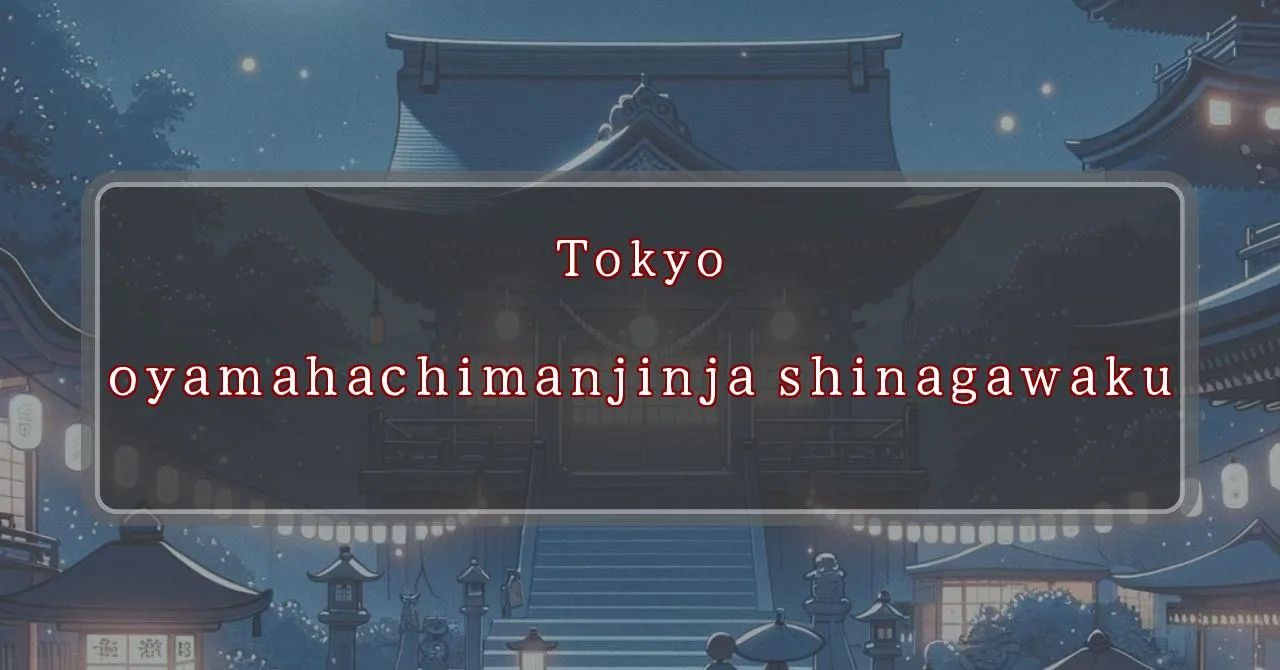Divine illumination at Tokyo’s Oyama Hachimangu Shrine
Basic Information
Oyama Hachimangu Shrine is a Shinto shrine located in the Ebara district of Shinagawa, Tokyo, Japan. It is dedicated to the god Hachiman, the patron deity of warriors and the guardian of the nation.
- Address: 7-5-14 Ebara, Shinagawa-ku, Tokyo 142-0063
- Phone Number: 03-3783-0455
- Access: A 7-minute walk from Nishi-小山 Station on the Tokyu Meguro Line
- Festival Days: September 6th (Sat) and 7th (Sun), 2024
Main Events and Attractions of the Festival
The Oyama Hachimangu Shrine Festival is a two-day annual event held on the first weekend of September. It is one of the most popular festivals in the Shinagawa area and attracts large crowds of visitors each year.
Mikoshi Procession
The highlight of the festival is the mikoshi procession, which takes place on the second day. Two mikoshi (portable shrines) are carried through the streets of Ebara by teams of people, accompanied by music and dancing. The procession is a lively and colorful spectacle that is sure to impress visitors.
Kagura Performance
Kagura is a traditional Japanese Shinto dance and music performance that is often performed at festivals. At the Oyama Hachimangu Shrine Festival, kagura is performed by local children and adults in the shrine’s main hall. The performances are a beautiful and moving way to learn about Japanese culture and tradition.
Food and Games
In addition to the mikoshi procession and kagura performance, the festival also features a variety of food and game stalls. Visitors can enjoy traditional Japanese festival foods such as yakitori (grilled chicken skewers), takoyaki (octopus balls), and kakigori (shaved ice). There are also a variety of games and activities for children, such as goldfish scooping and ring toss.
- Food Stalls: A variety of traditional Japanese festival foods are available, such as yakitori, takoyaki, and kakigori.
- Game Stalls: There are a variety of games and activities for children, such as goldfish scooping and ring toss.
Blessings and Deities
Oyama Hachimangu Shrine is dedicated to the god Hachiman, the patron deity of warriors and the guardian of the nation. Hachiman is said to be the divine spirit of Emperor Ojin, who ruled Japan in the 4th century. He is revered for his bravery and military prowess, and is often depicted as a warrior clad in armor, riding a white horse.
- Blessings: Hachiman is believed to bestow blessings of victory, success, and protection. He is also revered as a god of agriculture and fertility.
- Deities: In addition to Hachiman, Oyama Hachimangu Shrine also enshrines several other deities, including Amaterasu Omikami, the sun goddess and the legendary ancestor of the Japanese imperial family; Susanoo-no-Mikoto, the god of storms and the sea; and Inari Okami, the god of rice and prosperity.
Origin and History
The origins of Oyama Hachimangu Shrine are unclear, but it is believed to have been founded in the 11th century. The shrine was originally located on a hilltop in Ebara, but it was moved to its current location in the 16th century. The shrine has been rebuilt several times over the centuries, most recently in 1935.
- Foundation: Believed to have been founded in the 11th century.
- Relocation: Moved to its current location in the 16th century.
- Rebuildings: Rebuilt several times over the centuries, most recently in 1935.
Tips and Notes for Visitors
Here are some tips and notes for visitors to Oyama Hachimangu Shrine:
- Dress Code: There is no strict dress code for visiting the shrine, but it is considered respectful to dress modestly.
- Photography: Photography is generally permitted within the shrine grounds, but it is important to be respectful of other visitors and avoid taking pictures during religious ceremonies.
- Offerings: Visitors can make offerings to the gods at the shrine by purchasing ema (wooden plaques) or omikuji (paper fortunes).
- Festivals: Oyama Hachimangu Shrine holds several festivals throughout the year, including the annual Oyama Hachimangu Shrine Festival in September.
Parking Information
There is a small parking lot available at Oyama Hachimangu Shrine, but it is often full during popular times. Visitors are advised to use public transportation or park in a nearby parking lot and walk to the shrine.
- Parking Lot: Small parking lot available at the shrine.
- Public Transportation: The shrine is a 7-minute walk from Nishi-小山 Station on the Tokyu Meguro Line.
Popular Stalls and Food Carts in Recent Years
| Type of Stall | Description |
|---|---|
| Takoyaki | A staple at Japanese festivals. Characterized by a crispy outside and a creamy inside. |
| Jaga Butter | A simple yet popular snack of hot potatoes lavishly topped with melted butter. |
| Baby Castella | Small castella cakes, sweet and fluffy treats enjoyed by children and adults alike. |
| Grilled Ayu with Salt | Fresh ayu fish grilled whole with salt, a savory taste of Japanese summer. |
| Shaapin | A unique gourmet item influenced by foreign cuisine, with a chewy skin wrapping the filling. |
| Okonomiyaki | A Japanese grilled dish where you often choose your own ingredients for a personalized flavor. |
| Cotton Candy | A fluffy, sweet snack that’s extremely popular with children. |
| Chocolate Banana | A banana coated in chocolate, a fun and visually appealing dessert. |
| Kushiyaki | Various types of ingredients skewered and grilled, an easy-to-enjoy snack. |
| Yakisoba | Fried noodles mixed with a special sauce, a fast food favorite in Japan. |



